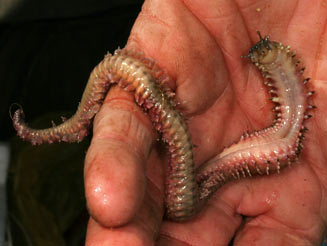|
Annelida (segmented worms, including earthworms, leeches and polychaetes)
Life >
Eukaryotes
>
Opisthokonta >
Metazoa
(animals) > Bilateria > Lophotrochozoa
 |
 |
|
Earthworm (Oligochaeta). [photo H. Robertson,
Iziko ©] |
Polychaete worm (Pseudonereis variegata)
collected by fisherman for bait, from mussel bed. [photo H. Robertson,
Iziko ©] |
Introduction
Annelids are segmented worms. The well developed coelom
(fluid filled body cavity) acts as a hydrostatic skeleton with muscles of the
body walls acting on it. The body segments of an annelid are partitioned by
internal divisions called septa, giving independence of movement to each of
them. Segmentation and a tube within a tube body plan have resulted in relative
specialisation of the digestive tract into a pharynx, a stomach, and accessory
glands. Cephalisation or head formation is apparent in some annelids, most
notably the polychaetes, and in these tentacles, palps and eyespots are
common.
There are over 15,000 species of annelids known globally
and they are generally divided into three classes. The Polychaeta have separate
sexes and posses soft projections called parapodia with many bristle-like chetae
per segment, no clitellum (fused mid-body segment that secretes mucous), a
distinct head (with eyes and tentacles), approximately 200 segments, with the
majority being marine. The Oligochaeta or eathworms are hermaphroditic and
posses no or few chaetae, no parapodia, a clitellum, no distinct head and
100-120 segments with very few marine forms. The Hirudinea or leeches are
blood eating parasites, which are hermaphroditic and posses no chaetae or
parapodia, a temporary clitellum, no head, a fixed 33-34 segments and a single
sucker at the posterior and anterior end, with very few marine forms. At
present ~766 marine Annelid species are known from South Africa.
Ecology
Polychaetes represent the largest class of annelids and are
predominantly marine. This class is divided into two groups; the sedentary
polychaetes and the errant or free living polychaetes. Sedentary polychaetes
spend most of their time in tubes or permanent burrows. Errant polychaetes
include free-moving pelagic forms, active burrowers, crawlers and the tube worms
that leave their tubes for breeding and feeding. Some polychaetes are ferocious
predators, using their strong chitinous jaws that extend with a part of the
pharynx when the animal is feeding. Others are sessile, housed in a burrow or
tube, with only their tentacles that form a funnel-shaped fan extended into the
surrounding water to filter out prey items. Members of the Oligochaeta and
Hirudinea are primarily found in terrestrial or freshwater habitats
respectively.
 |
 |
| The Cape reef-worm
Gunnarea capensis, a common sedentary polychaete found all round
the southern African coast,extracted from its burrow. [photo H.
Robertson, Iziko ©] |
Gunnarea capensis contracted
within burrow. [photo H. Robertson, Iziko
©] |
Annelids and humans
The presence of earthworms in soil increases crop production.
The burrows they produce improve aeration of the soil,
facilitating water movement, while their castings readily combine
with organic debris to form humus and improve fertility of the soil.
Generally people cringe when even the slightest mention of a leech
is made. Their parasitic blood sucking mode of feeding stirs
emotions of disgust, but medicinally harnessed, this ability has
been used for centuries in blood-letting and a number of other
procedures, including reconstructive surgery of severed digits and
plastic surgery. Polychaetes play a role in biomonitoring of the
marine environment (e.g. pollution and mining) and are commonly used
as bait organisms, but may be destructive as demonstrated by their
boring and fouling activity.
|
 |
Classification
|
Polychaeta (polychaetes) |
 |
|
Oligochaeta
(earthworms) |

|
|
Hirudinea (leaches) |
|
Links
Further reading
-
Branch, G. and Branch, M. 1981. The Living
Shores of Southern Africa. C. Struik Publishers, Cape Town.
Text by Wayne K. Florence and Dylan
Clarke |
|
